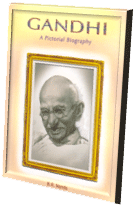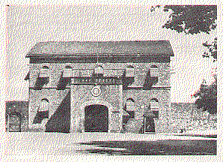
P.O. SEVAGRAM, DIST.WARDHA 442102, MS, INDIA. Phone: 91-7152-284753
FOUNDED BY MAHATMA GANDHI IN 1936
BIOGRAPHY OF GANDHI
GANDHI - A PICTORIAL BIOGRAPHY
by Shri B. R. Nanda

GANDHI
- A PICTORIAL BIOGRAPHY
Shri B. R. Nanda
Table of Contents
- About Gandhi
- Childhood
- Off To England
- Briefless Barrister
- In The 'Dark Continent'
- The Young Politician
- Satyagraha Struggle In South Africa
- The Making Of The Mahatma
- Return To India
- Gandhi's Ashram
- World War I
- Rowlatt Bills
- Nonviolent Non-cooperation
- Arrest And Imprisonment
- Reaction And Recovery
- Declaration Of Complete Independence
- Gandhi-Irwin Pact
- Round Table Conference
- In London
- Resumption Of Struggle
- Campaign Against Untouchability
- A New Deal For The Village
- The New Constitution
- Hindu-Muslim Antagonism
- Nonviolence In A Violent World
- Cripps Mission
- "Quit India"
- Simla Conference
- Cabinet Mission
- Communal Conflagration
- Partition of India
- Mission of Peace
- The End
- Gandhi and Nonviolence
About This Book
This is the first pictorial biography of Gandhi in which the narrative-concise, readable and incisive is illustrated with contemporary photographs and facsimiles of letters, newspaper reports and cartoons, adding up to a fascinating flash-back on the life of Mahatma Gandhi and the struggle for Indian freedom led by him. There is a skilful matching in this book of text and illustrations, of description and analysis and of concrete detail and large perspective. This pictorial biography will revive many memories in those who have lived through the Gandhian era; it should also be of interest to the post-independence generation.
About Author
Shri B. R. Nanda - former Director, Nehru Memorial Museum and Library, New Delhi. His full-scale biography of Mahatma Gandhi has been published in India, Britain and the U.S.A. and translated into French, Spanish, Italian and several other languages
Chapter-20 : Campaign Against Untouchability

A new twist to the civil disobedience movement came in September 1932 when Gandhi, who was in Yeravda Jail, went on a fast as a protest against the segregation of the so-called "untouchables" in the electoral arrangement planned for the new Indian constitution. Uncharitable critics described the fast as a form of coercion, a political blackmail. Gandhi was aware that his fast did exercise a moral pressure, but the pressure was directed not against those who disagreed with him, but against those who loved him and believed in him. He did not expect his critics to react in the same way as his friends and co-workers, but if his self-crucifixion could demonstrate his sincerity to them, the battle would be more than half-won. He sought to prick the conscience of the people and to convey to them something of his own inner anguish at a monstrous social tyranny. The fast dramatized the issues at stake; ostensibly it suppressed reason, but in fact it was designed to free reason from that mixture of inertia and prejudice which had permitted the evil of untouchability, which condemned millions of Hindus to humiliation, discrimination and hardship.
The news that Gandhi was about to fast shook India from one end to the other. September 20, 1932, when the fast began, was observed as a day of fasting and prayer. At Shantiniketan, poet Tagore, dressed in black, spoke to a large gathering on the significance of the fast and the urgency of fighting an age-old evil. There was a spontaneous upsurge of feeling; temples, wells and public places were thrown open to the "untouchables". A number of Hindu leaders met the representatives of the untouchables; an alternative electoral arrangement was agreed upon, and received the approval of the British Government before Gandhi broke his fast.
More important than the new electoral arrangement was the emotional catharsis through which the Hindu community had passed. The fast was intended by Gandhi "to sting the conscience of the Hindu community into right religious action". The scrapping of separate electorates was only the beginning of the end of untouchability. Under Gandhi's inspiration, while he was still in prison, a new organization, Harijan Sevak Sangh was founded to combat untouchability and a new weekly paper, the Harijan, was started. Harijan means "children of God"; it was Gandhi's name for the "untouchables"
After his release Gandhi devoted himself almost wholly to the campaign against untouchability. On November 7, 1933, he embarked on a country-wide tour which covered 12,500 miles and lasted for nine months. The tour evoked great enthusiasm for the breaking down of the barriers which divided the untouchables from the rest of the Hindu community, but it also provoked the militancy of the orthodox Hindus. On June 25, while Gandhi was on his way to the municipal hall in Poona, a bomb was thrown at his party. Seven persons were injured, but Gandhi was unhurt. He expressed his "deep pity" for the unknown thrower of the bomb. "I am not aching for martyrdom," he said, "but if it comes in my way in the prosecution of what I consider to be the supreme duty in defence of the faith I hold in common with millions of Hindus, I shall have well earned it."
Gandhi's fast had aroused public enthusiasm, but diverted it from political to social issues. In May 1933, he suspended civil disobedience for six weeks. He revived it later, but confined it to himself. A year later he discontinued it: this was a recognition of the fact that the country was fatigued and in no mood to continue a campaign of defiance. These decisions disconcerted many of his adherents, who did not relish his moral and religious approach to political issues, and chafed at his self-imposed restraints. Gandhi sensed the critical mood in the Congress party and in October 1934, announced his retirement from it. For the next three years, not politics but village economics was his dominant interest.